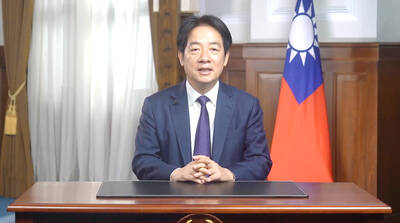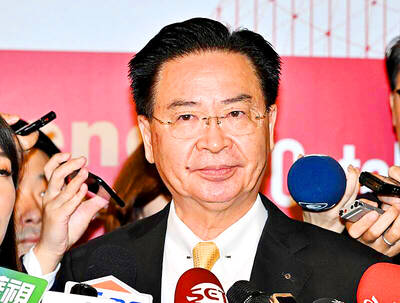Smilies are so 1990s. Emoticons have evolved to another level in Taiwan after users started making their own animated GIF files and swapping them through chat programs such as the popular MSN Messenger.
Emoticons have an extra twist in this country -- instead of a parenthetical aside, emoticons are now replacing Chinese characters as a part of the sentence.
And while Chinese language academics see this trend, along with the "martian language" (火星文) phenomenon -- in which letters and numbers are used to create the sounds of words -- as another sign of the fallen state of the Chinese language among the young, users can't seem to get enough of the elaborate emoticons for every occasion.
Indeed, it's been more than 25 years since US computer scientist Scott Elliot Fahlman came up with the idea of stringing together a colon, a dash and a parenthesis sign to make a "smiley face."
According to Fahlman's original post on the Carnegie Mellon online bulletin board on Sept. 19, 1982, he thought the sequence of characters could function as a "joke marker" for online conversations that get too heated.
"Read it sideways," advised Fahlman in the original post, retrieved after a massive verification effort digging through old archives.
Little could Falhman have anticipated that more than a quarter of a century later, his flippant suggestion could become a major component of digital communication for the Web-savvy citizens of a far-away country -- Taiwan.
While standard emoticons such as the "smiley" and the "winkey" have taken the world by storm and various software and chat programs now automatically render them into the ubiquitous yellow "smiley" face, the use of such bog-standard emoticons could simply mark one out as behind the times in this country, where the rise of custom animated emoticons have elevated the use of "smilies" to a major component of conversations rather than an aside.
"It all started three years ago, when an update of Microsoft's chat program Instant Messenger begin to support custom emoticons," said blogger Nokimi, who works as a Web site project manager.
Messenger, and other chat programs, have become ubiquitous in Taiwan and along with them the emoticons and animated emoticons that users can easily create and upload as GIFs.
"I would say that everybody I know who uses the 'net in Taiwan is also on MSN," Nokimi said.
He estimated that he has more than 30 online chat conversations a day, with friends, work colleagues and clients.
"At it's peak, my collection had more than 300 emoticons for my IM [Instant Messenger]," said "Annie," a reporter in Taipei who declined to be named for the purpose of this interview.
"Whenever I had a spare moment, I would go online to download some more. I wanted to have an emoticon that was fitting for every occasion. Unfortunately a virus that necessitated wiping my hard drive meant that I've had to start from scratch again," she said.
The world of animated emoticon has even produced its own superstar -- Onionhead. The character, with its distinctive spike of hair, features in a series of more than 70 animated emoticons, allowing users to express everything from getting sleepy, wiping sweat off their brow to laughing while wielding a hidden dagger.
Amy Chang of the Full Tone Art Co said, Onionhead's creator, "Ethan," is now working on new Onionhead emoticons and desktop pictures full-time. Although the downloads are free, Onionhead's popularity brings lucrative licensing opportunities.
The character is considered so popular among the young that the Planned Parenthood Association of Taiwan featured a specially commissioned Onionhead cartoon on the packaging of their condoms.
Onionhead's appeal has also reached overseas.
"It's hard to measure the popularity of Onionhead since most people swap them through IM rather than download them through our site," Chang said. "But we have licensed to merchandisers in China, Hong Kong and Macau."
However, there are complaints that the craze for emoticons has gone too far.
"I'm OK with an emoticon at the end of a sentence to highlight one's feelings, I'm even fine with emoticons that replace Chinese characters with the same character in a cutesy font," Nokimi said. "However, I cannot stand people who replace characters, or even multiple characters, with pictures."
This practice, known as "picture language" (
When Annie types the Chinese character for "no" her friends see a GIF animation of a man shaking his head.
Each sentence she types in IM might automatically bring up three or four such "picture language" icons.
"Friends have complained that I use too many icons when I chat on MSN," Annie said. "However, I don't think it's that hard to guess what I'm saying given the context. If they still can't figure it out, they can always right click to find out what the picture is meant to say."
"That's exactly what I find the most obnoxious about picture language users," Nokimi said. "Their desire to try something novel wastes my time."

US President Donald Trump yesterday announced sweeping "reciprocal tariffs" on US trading partners, including a 32 percent tax on goods from Taiwan that is set to take effect on Wednesday. At a Rose Garden event, Trump declared a 10 percent baseline tax on imports from all countries, with the White House saying it would take effect on Saturday. Countries with larger trade surpluses with the US would face higher duties beginning on Wednesday, including Taiwan (32 percent), China (34 percent), Japan (24 percent), South Korea (25 percent), Vietnam (46 percent) and Thailand (36 percent). Canada and Mexico, the two largest US trading

ACTION PLAN: Taiwan would expand procurement from the US and encourage more companies to invest in the US to deepen bilateral cooperation, Lai said The government would not impose reciprocal tariffs in retaliation against US levies, President William Lai (賴清德) said yesterday, as he announced five strategies to address the issue, including pledging to increase Taiwanese companies’ investments in the US. Lai has in the past few days met with administrative and national security officials, as well as representatives from various industries, to explore countermeasures after US President Donald Trump on Wednesday last week announced a 32 percent duty on Taiwanese imports. In a video released yesterday evening, Lai said that Taiwan would not retaliate against the US with higher tariffs and Taiwanese companies’ commitments to

‘SPECIAL CHANNEL’: Taipei’s most important tasks are to stabilize industries affected by Trump’s trade tariffs and keep negotiations with Washington open, a source said National Security Council Secretary-General Joseph Wu (吳釗燮) arrived in the US for talks with US President Donald Trump’s administration, a source familiar with the matter said on Friday. Wu was leading a delegation for a meeting known as the “special channel,” the Financial Times reported earlier. It marked Trump’s first use of the channel since returning to the White House on Jan. 20. Citing a source familiar with the matter, the Financial Times reported that Minister of Foreign Affairs Lin Chia-lung (林佳龍) was also a part of the delegation. The visit came days after China concluded war games around Taiwan and amid Trump’s

CHIP EXCEPTION: An official said that an exception for Taiwanese semiconductors would have a limited effect, as most are packaged in third nations before being sold The Executive Yuan yesterday decried US President Donald Trump’s 32 percent tariff on Taiwanese goods announced hours earlier as “unfair,” saying it would lodge a representation with Washington. The Cabinet in a statement described the pledged US tariffs, expected to take effect on Wednesday next week, as “deeply unreasonable” and “highly regrettable.” Cabinet spokeswoman Michelle Lee (李慧芝) said that the government would “lodge a solemn representation” with the US Trade Representative and continue negotiating with Washington to “ensure the interests of our nation and industries.” Trump at a news conference in Washington on Wednesday announced a 10 percent baseline tariff on most goods